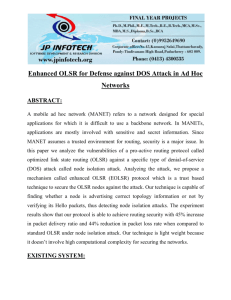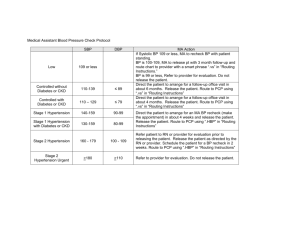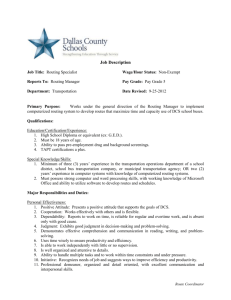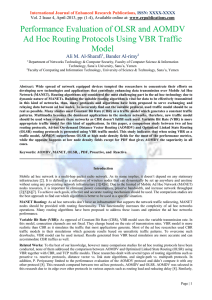Quality of Services Provides Proactive Routing Protocol in Manet
advertisement
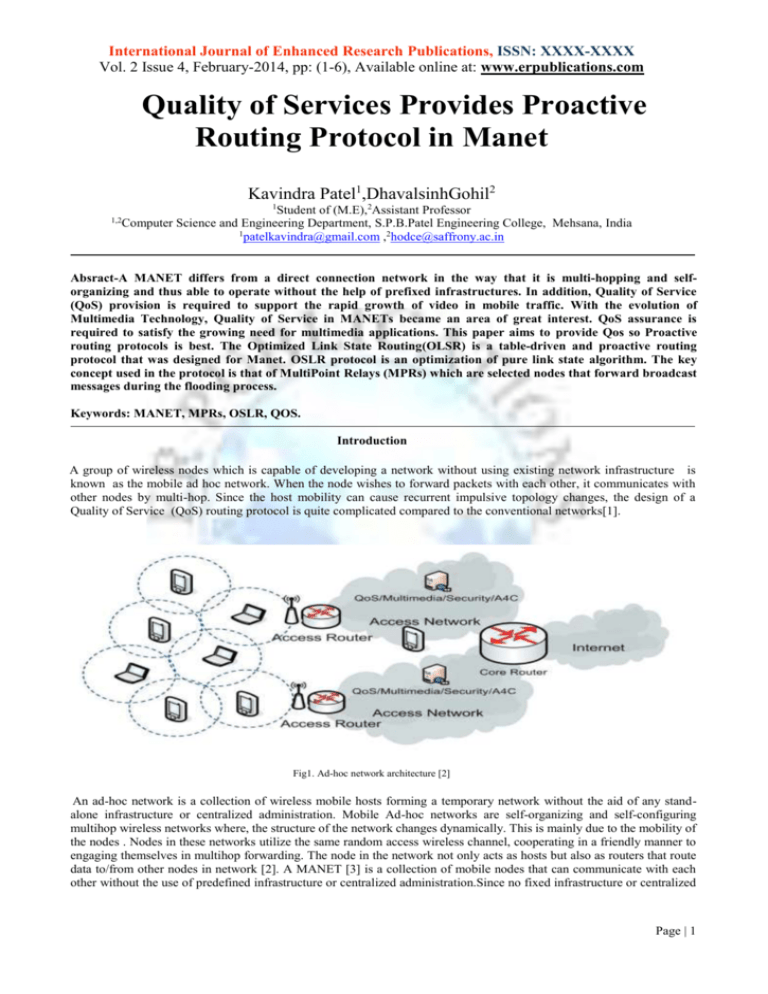
International Journal of Enhanced Research Publications, ISSN: XXXX-XXXX Vol. 2 Issue 4, February-2014, pp: (1-6), Available online at: www.erpublications.com Quality of Services Provides Proactive Routing Protocol in Manet Kavindra Patel1,DhavalsinhGohil2 1 1,2 Student of (M.E),2Assistant Professor Computer Science and Engineering Department, S.P.B.Patel Engineering College, Mehsana, India 1 patelkavindra@gmail.com ,2hodce@saffrony.ac.in Absract-A MANET differs from a direct connection network in the way that it is multi-hopping and selforganizing and thus able to operate without the help of prefixed infrastructures. In addition, Quality of Service (QoS) provision is required to support the rapid growth of video in mobile traffic. With the evolution of Multimedia Technology, Quality of Service in MANETs became an area of great interest. QoS assurance is required to satisfy the growing need for multimedia applications. This paper aims to provide Qos so Proactive routing protocols is best. The Optimized Link State Routing(OLSR) is a table-driven and proactive routing protocol that was designed for Manet. OSLR protocol is an optimization of pure link state algorithm. The key concept used in the protocol is that of MultiPoint Relays (MPRs) which are selected nodes that forward broadcast messages during the flooding process. Keywords: MANET, MPRs, OSLR, QOS. Introduction A group of wireless nodes which is capable of developing a network without using existing network infrastructure is known as the mobile ad hoc network. When the node wishes to forward packets with each other, it communicates with other nodes by multi-hop. Since the host mobility can cause recurrent impulsive topology changes, the design of a Quality of Service (QoS) routing protocol is quite complicated compared to the conventional networks[1]. Fig1. Ad-hoc network architecture [2] An ad-hoc network is a collection of wireless mobile hosts forming a temporary network without the aid of any standalone infrastructure or centralized administration. Mobile Ad-hoc networks are self-organizing and self-configuring multihop wireless networks where, the structure of the network changes dynamically. This is mainly due to the mobility of the nodes . Nodes in these networks utilize the same random access wireless channel, cooperating in a friendly manner to engaging themselves in multihop forwarding. The node in the network not only acts as hosts but also as routers that route data to/from other nodes in network [2]. A MANET [3] is a collection of mobile nodes that can communicate with each other without the use of predefined infrastructure or centralized administration.Since no fixed infrastructure or centralized Page | 1 International Journal of Enhanced Research Publications, ISSN: XXXX-XXXX Vol. 2 Issue 4, February-2014, pp: (1-6), Available online at: www.erpublications.com administration is available, these networks are self-organized and end-to-end communication may require routing information via several intermediate nodes. A. Applications Of Manet Below represents an application of MANET. Typical applications include [2]: a) Military battlefield b) Commercial Sector c) Local level d) Personal Area Network (PAN) B. Challenges of Manet The following list of challenges shows the inefficiencies and limitations that have to be overcome in a MANET environment [2]: a) Limited wireless transmission range b) Routing Overhead c) Battery Constraints d) Asymmetric Links e) Time-Varying Wireless Link Characteristics f) Broadcast Nature of t he Wireless Medium g) Packet losses due to transmission errors h) Mobility-induced route changes i) Potentially frequent network partitions C. Routing in a MANET Routing [4] is the process in which a route from a source to a destination node is identified. In order to facilitate communication within MANET, a routing protocol is used to discover routes between nodes. The primary goal of such a routing protocol is to ensure correct and efficient route establishment between a pair of nodes so that messages are delivered in a timely manner [5]. a) Proactive routing or Table driven routing b) Reactive routing or On demand routing c) Hybrid routing Table 1: Proactive versus Reactive Protocols Protocol Points(+/-) Proactive Reactive Advantages A route can be selected immediately without delay. Lower bandwidth is used for maintaining routing tables. More energy-efficient. Effective route maintenance. Disadvantages Produces more control traffic. Takes a lot of bandwidth. Produces network congestion. Have higher latencies when it comes to route discovery. Example DSDV,OSLR,WRP,CGSR AODV,DSR,ACOR,ABR Page | 2 International Journal of Enhanced Research Publications, ISSN: XXXX-XXXX Vol. 2 Issue 4, February-2014, pp: (1-6), Available online at: www.erpublications.com Introduction of QOS D. What is Quality-of-Service (QoS)? Quality of service (QoS) is a measure of the level of service that a particular data gets in the network. The network is expected to guarantee a set of measurable prespecified service attributes to the users in terms of end-to-end performance such as delay, bandwidth, probability of packet loss, delay variance (jitter), and so forth. Power consumption is another QoS attribute which is more specific to mobile ad hoc networks (MANETs). E. QoS Routing Fig 2. A sample QoS Routing in MANET [6] The above figure shows the wireless network derived from a sample Mobile Ad hoc Network. A – K are the mobile nodes. The numbers beside each link depicts the available bandwidths of the wireless links. Assume that, we want to find a route from node A to node G. The route A-B-H-G would be chosen if the shortest path is considered. But, the QoS-based route selection process might select a completely different path. The feasible route will be A-B-C-D-E-F-G, if the QoS metric is considered as the minimum band width of 4. The shortest path route AB- H-G will not be enough to provide the required bandwidth [6]. F. Why Quality-of-Service (QoS)? In the past decades mobile traffic, which by definition refers to data generated by handsets, laptops and mobile broadband gateways, has been growing rapidly annually. According to a survey by Cisco, mobile data in 2010 was triple the volume of the entire global Internet traffic in 2000. The growth rate in the previous year was 159%, which is 10% higher than anticipated in 2009. This rapid growth in mobile data is forecast to continue for the next five years with an average annual growth of 92%. There are several reasons why mobile traffic has grown so quickly. Firstly, mobile video, which requires high bit rates, is considered to lead to the increase of mobile traffic. It is reported that mobile video reached as high as 49.8% of total mobile traffic in 2010 and will account for two thirds of mobile traffic by 2015. Moreover, Internet gaming, which consumes, on average, 63 PB per month in 2009, also results in a growth in mobile traffic and it is expected to achieve an annual growth of 37% in the coming five years. Last but not the least, Voice over IP (VoIP) which includes phone-based VoIP services direct from or transported by a third party to a service provider, and software-based internet VoIP such as Skype, leads to the expansion of mobile traffic. G. Optimized Link State Routing (OLSR) protocol OLSR (Optimized Link State Routing) is an optimization of a pure link state routing protocol. It is based on the concept of multipoint relays (MPRs). First, using multipoint relays reduces the size of the control messages: rather than declaring all its links to all nodes in the network, a node declares only the set of links with its neighbors that have selected it as Page | 3 International Journal of Enhanced Research Publications, ISSN: XXXX-XXXX Vol. 2 Issue 4, February-2014, pp: (1-6), Available online at: www.erpublications.com “multipoint relay”. The use of MPRs also minimizes flooding of control traffic.[7] The Optimized Link State Routing (OLSR) protocol to find a route with larger bandwidth (OLSR-based). This approach does not modify the routing scheme of OLSR, but it chooses different criteria that incorporate bandwidth into consideration to select the multipoint relay (MPR) set so as to find a larger bandwidth route. Route maintenance and resource reservation are not considered in this protocol [8]. MPR selection is the key point in OLSR. The smaller the MPR set is, the less overhead the protocol introduces. The proposed heuristic in for MPR selection is to iteratively select a 1-hop neighbor which reaches the maximum number of uncovered 2-hop neighbors as MPR. [9] If there is a tie, the one with higher degree (more neighbors) is chosen. Table 2 shows how node B selects MPR(s), based on the network depicted in Figure 3: Table 2. MPR selection in OLSR Nodes B 1 hop Neighbors 2 hop Neighbors MPR(s) A,C,F,G D,E C Fig 3. Network example for MPR Selection H. Changing the MPR Selection Criteria The decision of how each node selects its MPRs is essential to determining the optimal bandwidth route in the network. In the MPR selection, a “good bandwidth” link should not be omitted. In other words, as many nodes as possible that have high bandwidth links connecting to the MPR selector must be included into the MPR sets. Based on this idea, several revised MPR selection algorithms are presented in future work.[9]. Related Work A. Quality of Service Routing in a MANET with OLSR. The classical OLSR in terms of QoS perceived by the users (e.g. bandwidth amount granted to a flow and delivery rate). The efficiency of the optimized flooding is equal to that provided by the native version of OLSR.[7] Issue a) Bandwidth calculation is not done. It is assumed that each node knows the bandwidth of communication link which is very difficult to find. b) Delay estimation is not considered in this paper. c) Cross layer design is used which is very much challenging and difficult to implement. B. Intelligent OLSR Routing Protocol Optimization for VANETs. Authors have addressed the optimal parameter tuning of the OLSR routing protocol to be used in VANETs by using an automatic optimization tool. For this task, authors have defined an optimization strategy based on coupling optimization algorithms (PSO, DE, GA, and SA) and the ns − 2 network simulator [10]. Issue Page | 4 International Journal of Enhanced Research Publications, ISSN: XXXX-XXXX Vol. 2 Issue 4, February-2014, pp: (1-6), Available online at: www.erpublications.com a) The proposed algorithm is for VANET not for MANET. MANET has slower mobility than VANET, so proposed algorithm can be suited to MANET. b) Here, meta-heuristic and ns2 simulator are coupled to generate the solution, but in case of MANET it is very difficult to find proper location for applying and implementing meta-heuristic. This coupling is also very time-consuming. Conclusion Quality of Service (QoS) provision is required to support the rapid growth of video in mobile traffic. The Optimized Link State Routing (OLSR) is a table-driven and proactive routing protocol that was designed for mobile ad hoc network. OLSR protocol is an optimization of the pure link state algorithm. The key concept used in the protocol is that of MultiPoint Relays (MPRs) which are selected nodes that forward broadcast messages during the flooding process. OLSR is a proactive routing protocol which is best suited for QoS provisioning. So OLSR will be modified by proposed method in order to assure QoS in OLSR routing. There are several other issues of OLSR as well. E.g. MRP Setup algorithm. The proposed method will also find the best way to choose MRP nodes for QoS routing. The proposed mechanism will be incorporated in OLSR routing protocol and will be implemented and simulated in NS2.In future Modifying original OLSR according to newly developed QoS-aware routing algorithm in NS2. References [1]. S.Venkatasubramanian, N.P.Gopalan, “Multi-path QoS Routing Protocol for Load Balancing in MANET”, International Journal of Networking & Parallel Computing , Volume 1, Issue 3, Dec2012-Jan2013. [2]. Jyoti, Nitasha Soni, “Comparative Study of Adhoc Routing Protocol AODV,DSR and DSDV in Mobile Adhoc NETwork International Journal of Applied Engineering Research,ISSN 0973-4562 Vol. 7 No.11 (2012). [3]. Sumit Mahajan, Vinay Chopra, “Performance Evaluation of MANET Routing Protocols with Scalabilityusing QoS Metrics of VOIP Applications”, International Journal of Advanced Research in Computer Science and Software Engineering , Volume 3, Issue 2, February 2013. [4]. Bharat Bhushan,Shailender Gupta,C.K.Nagpal, “Comparison of on Demand Routing Protocols”, I.J.Information Technology and Computer Science, 2013, 03, 61-68 Published Online February 2013 in MECS. [5]. M. Ravi Kumar, N. Geethanjali, “A Literature Survey of Routing Protocols in MANETs”, International Journal of Science and Research (IJSR), India Online ISSN: 2319‐ 7064, Volume 2 Issue 4, April 2013. [6]. Narendar Reddy Mandhadi and Lakshmi Rajamani, “QoS aware Hierarchical Multi-hop Routing Protocols in MANETs”,International Journal of Computer Science & Engineering Survey (IJCSES) Vol.4, No.1,February 2013. [7]. Dang-Quan Nguyen, Pascale Minet, “Quality of Service Routing in a MANET with OLSR”, Journal of Universal Computer Science, vol. 13, no. 1 (2007), 56-86. [8]. Lei Chen and Wendi B. Heinzelman, “A Survey of Routing Protocols that Support QoS in Mobile Ad Hoc Networks”, IEEE Network, Nov/Dec 2007. [9]. Ying Ge, Thomas Kunz, Louise Lamont, “Quality of Service Routing in Ad-Hoc Networks Using OLSR”, Proceedings of the 36th Hawaii International Conference on System Sciences (HICSS’03) 0-7695-1874-5/03 $17.00 © 2002 IEEE. [10]. Jamal Toutouh, José García-Nieto, and Enrique Alba, “Intelligent OLSR Routing Protocol Optimization for VANETs”, IEEE Transactions on Vehicular Technology, Vol. 61, No. 4, May 2012. Page | 5

